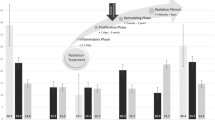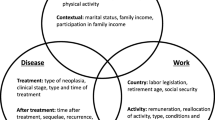Abstract
Introduction
A Canadian research team is conducting a multi-centered, non-interventional national study with the objective of charting the course of arm morbidity after breast cancer surgery. This paper examined the relationship between arm morbidity and leisure and recreational activities of affected women.
Methods
Five hundred and forty seven women with stage I-III breast cancer were recruited in four centers across Canada: Surrey (BC); Winnipeg (MB), Montreal (QB) and Fredericton (NB). Participants were enrolled in the study 6–12 months post surgery. Physical examination was used to assess arm and shoulder functioning and questionnaires were used to assess disability, pain, and participation in recreational and leisure activities.
Results
At the first clinical assessment (T1), the mean number of months post breast cancer surgery was 8.4. At T1 49% of women reported difficulty with recreational activities that involved “some force or impact” and 29% experienced negative changes to their involvement in leisure activities. A hierarchical multiple regression analysis found that several arm morbidity variables were significant predictors of difficulty with participation in recreational activities. A second hierarchical regression found also that arm morbidity factors were significant predictors of negative changes in leisure activities. Follow-up analyses found that arm morbidity, was most closely related to difficulty with recreational activities requiring free movement of the arm and using force.
Conclusion
Many women treated for breast cancer experience arm morbidity. Arm morbidity is related to difficulties with recreational activities and negative changes in leisure activity participation.
Implications
Breast cancer survivors should engage in recreational and leisure activities that are compatible with reduced range of motion and pain, and avoid those that exacerbate their arm morbidity.
Similar content being viewed by others
Notes
Of the sample, 16% were diagnosed outside the 6 and 12 months post surgery range: 60 (10%) women <6 months and 35 (6%) >12 months. Statistics are based on all 574 women.
References
International Society of Lymphology. The diagnosis and treatment of peripheral lymphedema. Consensus document of the International Society of Lymphology. Lymphology. 2003;36(2), 84–91.
American Cancer Society. (2008). “Understanding Lymphedema.” from http://www.cancer.org/docroot/MIT/content/MIT_7_2x_Understanding_Lymphedema.asp.
Andrykowski MA, Beacham AO, et al. “Prospective, longitudinal study of leisure-time exercise in women with early-stage breast cancer.” Cancer Epidemiol Biomarkers Prev. 2007;16(3):430–8.
Beaton DE, Katz JN, Fossel AH, Wright JG, Tarasuk V, Bombardier C. “Measuring the whole or the parts? Validity, reliability, and responsiveness of the disabilities of the arm, shoulder and hand outcome measure in different regions of the upper extremity.” J Hand Ther. 2001;14(2):128–46.
Brennan MJ, DePompolo RW, Garden FH. “Focused review: postmastectomy lymphedema.” Arch Phys Med Rehabil. 1996;77(3 Suppl):S74–80.
Myers Lowe R. Lymphedema. Cancerpage.com. Accessed April 5, 2008. http://www.cancerpage.com/center/sideeffects/Lymphedema.asp
Coster S, Poole K, Fallowfield LJ. “The validation of a quality of life scale to assess the impact of arm morbidity in breast cancer patients post-operatively.” Breast Cancer Res Treat. 2001;68(3):273–82.
Dorval M, Maunsell E, Deschenes L, Brisson J, Masse B. “Long-term quality of life after breast cancer: comparison of 8-year survivors with population controls.” J Clin Oncol. 1998;16(2):487–94.
Engel J, Kerr J, Schlesinger-Raab A, Sauer H, Hölzel D. “Axilla surgery severely affects quality of life: results of a 5-year prospective study in breast cancer patients.” Breast Cancer Res Treat. 2003;79(1):47–57.
Harris SR, Niesen-Vertommen SL. “Challenging the myth of exercise-induced lymphedema following breast cancer: a series of case reports.” J Surg Oncol. 2000;74(2):95–8. discussion 98–9.
Karges JR, Mark BE, Stikeleather SJ, Worrell TW. “Concurrent validity of upper-extremity volume estimates: comparison of calculated volume derived from girth measurements and water displacement volume.” Phys Ther. 2003;83(2):134–45.
Karki A, Simonen R, Mälkiä E, Selfe J. “Impairments, activity limitations and participation restrictions 6 and 12 months after breast cancer operation.” J Rehabil Med. 2005;37(3):180–8.
Keays KS, Harris SR, Lucyshyn JM, MacIntyre DL. “Effects of pilates exercises on shoulder range of motion, pain, mood, and upper-extremity function in women living with breast cancer: a pilot study.” Phys Ther. 2008;88(4):494–510.
Kwan W, Jackson J, Weir LM, Dingee C, McGregor G, Olivotto IA. “Chronic arm morbidity after curative breast cancer treatment: prevalence and impact on quality of life.” J Clin Oncol. 2002;20(20):4242–8.
Mackenzie D. “Abreast in a boat-race against breast cancer.” Can Med Assoc J. 1998;159:376–8.
Miedema B, Hamilton R, Easley MA. “From “invincibility” to “normalcy”: coping strategies of young adults during the cancer journey.” Palliative & Supportive Care. 2007;5(1):41–9.
Pain SJ, Purushotham AD. “Lymphoedema following surgery for breast cancer.” Br J Surg. 2000;87(9):1128–41.
Rietman JS, Dijkstra PU, Hoekstra HJ, Eisma WH, Szabo BG, Groothoff JW, et al. “Late morbidity after treatment of breast cancer in relation to daily activities and quality of life: a systematic review.” Eur J Surg Oncol. 2003;29(3):229–38.
Rockson SG. “Precipitating factors in lymphedema: myths and realities.” Cancer. 1998;83(12 Suppl American):2814–6.
Shannon C, Shaw SM. “If the dishes don’t get done today, they’ll get done tomorrow”: a breast cancer experience as a catalyst for changes to women’s leisure.” J Leis Res. 2005;37(2):195–215.
Shimozuma K, Ganz PA, Petersen L, Hirji K. “Quality of life in the first year after breast cancer surgery: rehabilitation needs and patterns of recovery.” Breast Cancer Res Treat. 1999;56(1):45–57.
Smith WC, Bourne D, Squair J, O. Phillips D, Alastair Chambers W. “A retrospective cohort study of post mastectomy pain syndrome.” Pain. 1999;83(1):91–5.
Thomas-MacLean R, Miedema B, Tatemichi SR. “Breast cancer-related lymphedema: women’s experiences with an underestimated condition.” Can Fam Physician. 2005;51:246–7.
Thomas-MacLean RL, Hack T, Kwan W, Towers A, Miedema B, Tilley A. “Arm morbidity and disability after breast cancer: new directions for care.” Oncol Nurs Forum. 2008;35(1):65–71.
Acknowledgement
Canadian Institutes of Health Research (CIHR) MOP 68883
Author information
Authors and Affiliations
Corresponding author
Rights and permissions
About this article
Cite this article
Miedema, B., Hamilton, R., Tatemichi, S. et al. Predicting recreational difficulties and decreased leisure activities in women 6–12 months post breast cancer surgery. J Cancer Surviv 2, 262–268 (2008). https://doi.org/10.1007/s11764-008-0068-8
Received:
Accepted:
Published:
Issue Date:
DOI: https://doi.org/10.1007/s11764-008-0068-8




